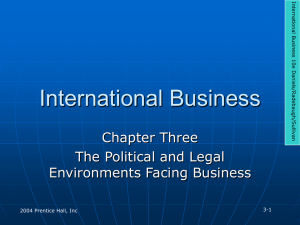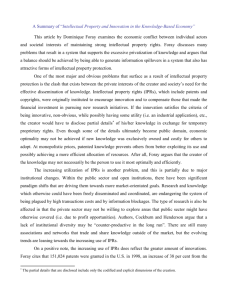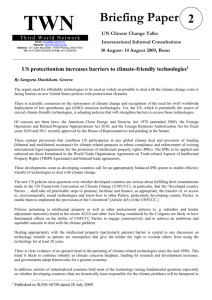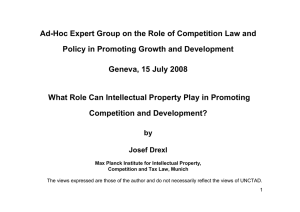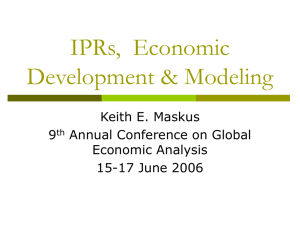doc - PIIPA
advertisement
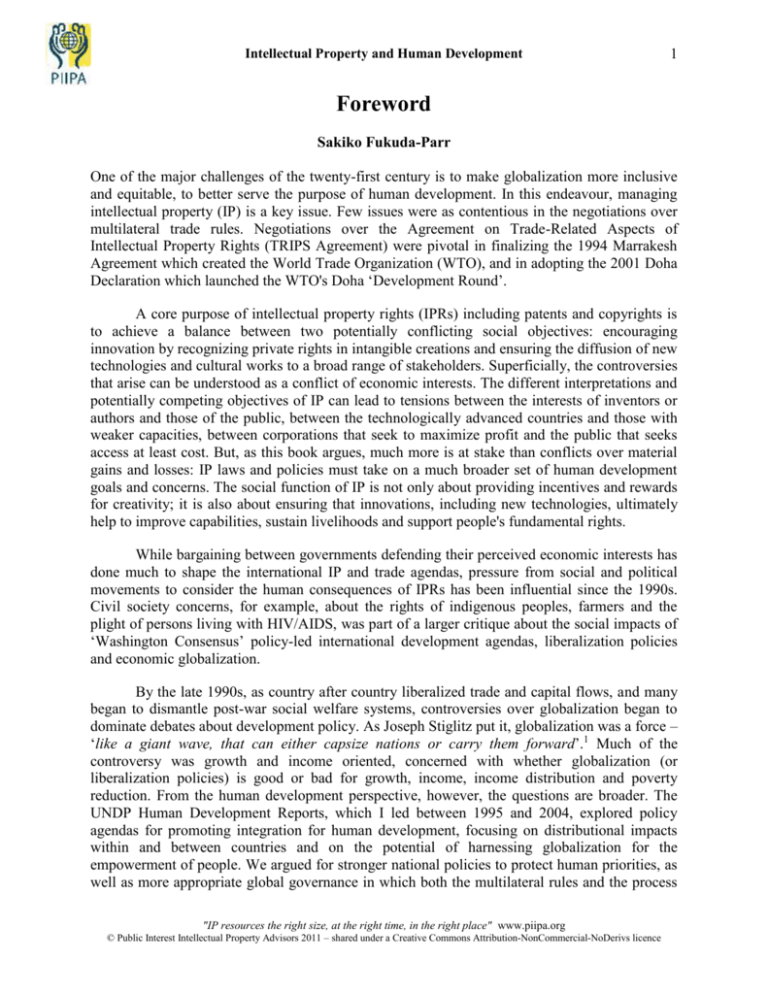
Intellectual Property and Human Development 1 Foreword Sakiko Fukuda-Parr One of the major challenges of the twenty-first century is to make globalization more inclusive and equitable, to better serve the purpose of human development. In this endeavour, managing intellectual property (IP) is a key issue. Few issues were as contentious in the negotiations over multilateral trade rules. Negotiations over the Agreement on Trade-Related Aspects of Intellectual Property Rights (TRIPS Agreement) were pivotal in finalizing the 1994 Marrakesh Agreement which created the World Trade Organization (WTO), and in adopting the 2001 Doha Declaration which launched the WTO's Doha ‘Development Round’. A core purpose of intellectual property rights (IPRs) including patents and copyrights is to achieve a balance between two potentially conflicting social objectives: encouraging innovation by recognizing private rights in intangible creations and ensuring the diffusion of new technologies and cultural works to a broad range of stakeholders. Superficially, the controversies that arise can be understood as a conflict of economic interests. The different interpretations and potentially competing objectives of IP can lead to tensions between the interests of inventors or authors and those of the public, between the technologically advanced countries and those with weaker capacities, between corporations that seek to maximize profit and the public that seeks access at least cost. But, as this book argues, much more is at stake than conflicts over material gains and losses: IP laws and policies must take on a much broader set of human development goals and concerns. The social function of IP is not only about providing incentives and rewards for creativity; it is also about ensuring that innovations, including new technologies, ultimately help to improve capabilities, sustain livelihoods and support people's fundamental rights. While bargaining between governments defending their perceived economic interests has done much to shape the international IP and trade agendas, pressure from social and political movements to consider the human consequences of IPRs has been influential since the 1990s. Civil society concerns, for example, about the rights of indigenous peoples, farmers and the plight of persons living with HIV/AIDS, was part of a larger critique about the social impacts of ‘Washington Consensus’ policy-led international development agendas, liberalization policies and economic globalization. By the late 1990s, as country after country liberalized trade and capital flows, and many began to dismantle post-war social welfare systems, controversies over globalization began to dominate debates about development policy. As Joseph Stiglitz put it, globalization was a force – ‘like a giant wave, that can either capsize nations or carry them forward’.1 Much of the controversy was growth and income oriented, concerned with whether globalization (or liberalization policies) is good or bad for growth, income, income distribution and poverty reduction. From the human development perspective, however, the questions are broader. The UNDP Human Development Reports, which I led between 1995 and 2004, explored policy agendas for promoting integration for human development, focusing on distributional impacts within and between countries and on the potential of harnessing globalization for the empowerment of people. We argued for stronger national policies to protect human priorities, as well as more appropriate global governance in which both the multilateral rules and the process "IP resources the right size, at the right time, in the right place" www.piipa.org © Public Interest Intellectual Property Advisors 2011 – shared under a Creative Commons Attribution-NonCommercial-NoDerivs licence Intellectual Property and Human Development 2 for their formulation would be inclusive and equitable. One major question relating to IP was the nexus between technology, globalization and human development. Breakthrough science in information communications and biotechnology was a key driver of globalization; the computer and the Internet have made possible the mass dissemination of information, and high-yielding varieties of rice and maize have turned food-deficit countries into major food exporters. History has shown, however, that breakthrough technologies can be a source not only of opportunities for improving human well-being, but also of new inequalities. Although the social function of IP is not only about incentivizing technological innovations, it is important to design appropriate IP policies and laws to ensure that new technologies ultimately enlarge genuine choices and foster human development. As stated earlier, the analysis of IPRs and their broad range of social ramifications go beyond economic considerations. Economic analysis framed in the utilitarian perspective of providing incentives for more material production is particularly limiting in this context. The utilitarian perspective is at best neglectful of, and at worst blind to, the effects on distribution of benefits and costs, the far-reaching social consequences of technological innovation, the social priority in technological innovation and diffusion that can solve enduring problems of poverty, and the claims that human beings have basic rights to participate in and benefit from innovations and creative expressions. Intellectual property rights are intended to promote innovation, but research has shown that this is not always the case and that IPRs can also put obstacles in front of research and innovation. They are intended to reward creators, but in certain contexts fail to recognize the creativity and innovation of local communities and other social networks. They are intended to fulfil a social purpose, but that purpose can be too narrowly defined and miss out on some essential human challenges. As the chapters in this volume show, the range of legal rights within the umbrella of IP impact human capabilities and endeavours in complex ways. The human development and capabilities approach provides a broad and useful framework for analysing the social impact of IPRs because the approach defines the purpose of development as enlarging the choices and capabilities that people have to lead a life they value. This framework focuses on a wide range of actual and potential human consequences that are of concern to diverse peoples in the world. The wide range of challenges that different individuals and communities face, and the diversity of their priorities, is precisely what makes a single policy approach to IPRs inappropriate and impossible. How IP frameworks might be reformed to meet these diverse challenges requires greater exploration. It is also the shades of grey that make the topic fascinating to study. This is a unique volume that brings together scholarly papers on all the key issues of human development and intellectual property rights. I expect that this book will provide an enjoyable and informative read, and it will become a much valued resource for individuals at all levels of knowledge and involvement in the IP and international development spheres. 1 World Bank 2000, ‘World Bank Sees “Localization” as Major New Trend in 21st Century’, World Development Report 1999/2000 press release, available at: http://web.worldbank.org/WBSITE/EXTERNAL/NEWS/0,,contentMDK:20014638~pagePK:64257043~piPK:437376~theSit ePK:4607,00.html (accessed 28 October 2009) "IP resources the right size, at the right time, in the right place" www.piipa.org © Public Interest Intellectual Property Advisors 2011 – shared under a Creative Commons Attribution-NonCommercial-NoDerivs licence



